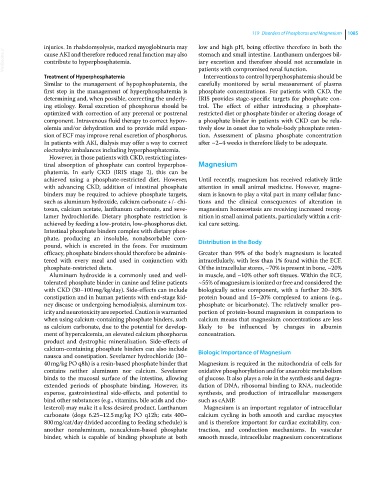Page 1147 - Clinical Small Animal Internal Medicine
P. 1147
119 Disorders of Phosphorus and Magnesium 1085
injuries. In rhabdomyolysis, marked myoglobinuria may low and high pH, being effective therefore in both the
VetBooks.ir cause AKI and therefore reduced renal function may also stomach and small intestine. Lanthanum undergoes bil
iary excretion and therefore should not accumulate in
contribute to hyperphosphatemia.
Interventions to control hyperphosphatemia should be
Treatment of Hyperphosphatemia patients with compromised renal function.
Similar to the management of hypophosphatemia, the carefully monitored by serial measurement of plasma
first step in the management of hyperphosphatemia is phosphate concentrations. For patients with CKD, the
determining and, when possible, correcting the underly IRIS provides stage‐specific targets for phosphate con
ing etiology. Renal excretion of phosphorus should be trol. The effect of either introducing a phosphate‐
optimized with correction of any prerenal or postrenal restricted diet or phosphate binder or altering dosage of
component. Intravenous fluid therapy to correct hypov a phosphate binder in patients with CKD can be rela
olemia and/or dehydration and to provide mild expan tively slow in onset due to whole‐body phosphate reten
sion of ECF may improve renal excretion of phosphorus. tion. Assessment of plasma phosphate concentration
In patients with AKI, dialysis may offer a way to correct after ~2–4 weeks is therefore likely to be adequate.
electrolyte imbalances including hyperphosphatemia.
However, in those patients with CKD, restricting intes
tinal absorption of phosphate can control hyperphos Magnesium
phatemia. In early CKD (IRIS stage 2), this can be
achieved using a phosphate‐restricted diet. However, Until recently, magnesium has received relatively little
with advancing CKD, addition of intestinal phosphate attention in small animal medicine. However, magne
binders may be required to achieve phosphate targets, sium is known to play a vital part in many cellular func
such as aluminum hydroxide, calcium carbonate +/‐ chi tions and the clinical consequences of alteration in
tosan, calcium acetate, lanthanum carbonate, and seve magnesium homeostasis are receiving increased recog
lamer hydrochloride. Dietary phosphate restriction is nition in small animal patients, particularly within a crit
achieved by feeding a low‐protein, low‐phosphorus diet. ical care setting.
Intestinal phosphate binders complex with dietary phos
phate, producing an insoluble, nonabsorbable com Distribution in the Body
pound, which is excreted in the feces. For maximum
efficacy, phosphate binders should therefore be adminis Greater than 99% of the body’s magnesium is located
tered with every meal and used in conjunction with intracellularly, with less than 1% found within the ECF.
phosphate‐restricted diets. Of the intracellular stores, ~70% is present in bone, ~20%
Aluminum hydroxide is a commonly used and well‐ in muscle, and ~10% other soft tissues. Within the ECF,
tolerated phosphate binder in canine and feline patients ~55% of magnesium is ionized or free and considered the
with CKD (30–100 mg/kg/day). Side‐effects can include biologically active component, with a further 20–30%
constipation and in human patients with end‐stage kid protein bound and 15–20% complexed to anions (e.g.,
ney disease or undergoing hemodialysis, aluminum tox phosphate or bicarbonate). The relatively smaller pro
icity and neurotoxicity are reported. Caution is warranted portion of protein‐bound magnesium in comparison to
when using calcium‐containing phosphate binders, such calcium means that magnesium concentrations are less
as calcium carbonate, due to the potential for develop likely to be influenced by changes in albumin
ment of hypercalcemia, an elevated calcium phosphorus concentration.
product and dystrophic mineralization. Side‐effects of
calcium‐containing phosphate binders can also include Biologic Importance of Magnesium
nausea and constipation. Sevelamer hydrochloride (30–
40 mg/kg PO q8h) is a resin‐based phosphate binder that Magnesium is required in the mitochondria of cells for
contains neither aluminum nor calcium. Sevelamer oxidative phosphorylation and for anaerobic metabolism
binds to the mucosal surface of the intestine, allowing of glucose. It also plays a role in the synthesis and degra
extended periods of phosphate binding. However, its dation of DNA, ribosomal binding to RNA, nucleotide
expense, gastrointestinal side‐effects, and potential to synthesis, and production of intracellular messengers
bind other substances (e.g., vitamins, bile acids and cho such as cAMP.
lesterol) may make it a less desired product. Lanthanum Magnesium is an important regulator of intracellular
carbonate (dogs 6.25–12.5 mg/kg PO q12h; cats 400– calcium cycling in both smooth and cardiac myocytes
800 mg/cat/day divided according to feeding schedule) is and is therefore important for cardiac excitability, con
another nonaluminum, noncalcium‐based phosphate traction, and conduction mechanisms. In vascular
binder, which is capable of binding phosphate at both smooth muscle, intracellular magnesium concentrations

